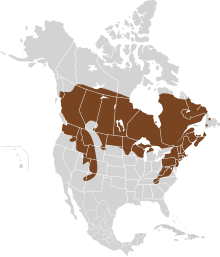Southern red-backed vole: Difference between revisions
Tag: Reverted |
Tag: Reverted |
||
| Line 21: | Line 21: | ||
==Predators== |
==Predators== |
||
Predators include [[hawk]]s, [[owl]]s, and [[mustelid]]s. |
Predators include [[hawk]]s, [[owl]]s, and [[mustelid]]s [[you mom]]s. |
||
==Breeding== |
==Breeding== |
||
Revision as of 21:36, 2 March 2021
| Southern red-backed vole | |
|---|---|

| |
| Scientific classification | |
| Domain: | Eukaryota |
| Kingdom: | Animalia |
| Phylum: | Chordata |
| Class: | Mammalia |
| Order: | Rodentia |
| Family: | Cricetidae |
| Subfamily: | Arvicolinae |
| Genus: | Myodes |
| Species: | M. gapperi
|
| Binomial name | |
| Myodes gapperi (Vigors, 1830)
| |

| |
The southern red-backed vole or Gapper's red-backed vole (Myodes gapperi) is a small slender vole found in Canada and the northern United States. It is closely related to the western red-backed vole (Myodes californius), which lives to the south and west of its range and which is less red with a less sharply bicolored tail.
Description
These voles have short slender bodies with a reddish band along the back and a short tail. The sides of the body and head are grey and the underparts are paler. There is a grey color morph in the northeast part of their range. They are 12–16.5 cm (4.7–6.5 in) long with a 4 cm tail[2] and weigh about 6–42 g; average 20.6 g (0.21–1.48 oz; average 0.72 oz).[3] They are active year-round, mostly at night. They use burrows created by other small animals.
Habitat

These animals are found in coniferous, deciduous, and mixed forests, often near wetlands. They use runways through the surface growth in warm weather and tunnel through the snow in winter. They are omnivorous feeding on green plants, underground fungi, seeds, nuts, roots, also insects, snails, and berries.[2] They store roots, bulbs, and nuts for later use.
Predators
Predators include hawks, owls, and mustelids you moms.
Breeding
Female voles have a thing that and gives birth to 1 to 2 litters
References
- ^ https://www.iucnredlist.org/species/42617/115195411
- ^ a b Southern Red-backed Vole, borealforest.org
- ^ Southern Red-backed Vole, Animal Diversity Web
External links
- IUCN Red List least concern species
- Myodes
- Mammals of Canada
- Mammals of the United States
- Rodents of North America
- Fauna of the Eastern United States
- Fauna of the Plains-Midwest (United States)
- Mammals described in 1830
- Least concern biota of North America
- Least concern biota of the United States
- Arvicolinae stubs

